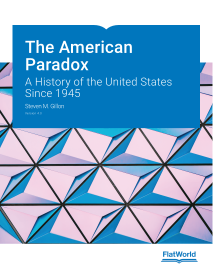Textbook Details

- By:
- Steven M. Gillon
- Published:
- February 2018
- Discipline:
- History Textbooks
- ISBN (Digital):
- 978-1-4533-8757-3
The American Paradox takes a comprehensive, nonpartisan approach to understanding the major events and social movements in American history since 1945. Throughout the text, Gillon focuses on the central contradiction of postwar politics and society: Americans expect their government to solve major social problems, but they retain a fear of federal power. Gillon uses politics and culture to serve as the building blocks for the narrative as he helps students continue to find connections between the past and present, so that they can better understand how the story of post-45 U.S. history is a tale of both unity and division—a uniquely American paradox.
Brief Table of Contents
Chapter 1: The Specter of Appeasement: The Cold War, 1945–1949
Chapter 2: In the Shadow of FDR
Chapter 3: The Cold War Heats Up
Chapter 4: Boomer Nation
Chapter 5: The Politics of Moderation, 1951–1960
Chapter 6: American Ideals and Social Realities, 1952–1960
Chapter 7: The Kennedy Presidency, 1961–1963
Chapter 8: Lyndon Johnson, the Great Society, and the Unraveling of America, 1963–1967
Chapter 9: “Into the Big Muddy”: America in Vietnam, 1945–1968
Chapter 10: Richard Nixon and the New Republican Majority, 1969–1974
Chapter 11: The Clash of Cultures, 1969–1980
Chapter 12: The Age of Limits, 1974–1980
Chapter 13: The Reagan Presidency, 1981–1989
Chapter 14: Culture and Consumerism: 1980–1992
Chapter 15: The End of the Cold War, 1988–1992
Chapter 16: The Clinton Presidency, 1993–2001
Chapter 17: The Prosperous Nineties
Chapter 18: The Challenges of the New Century, 2001 to the Present
